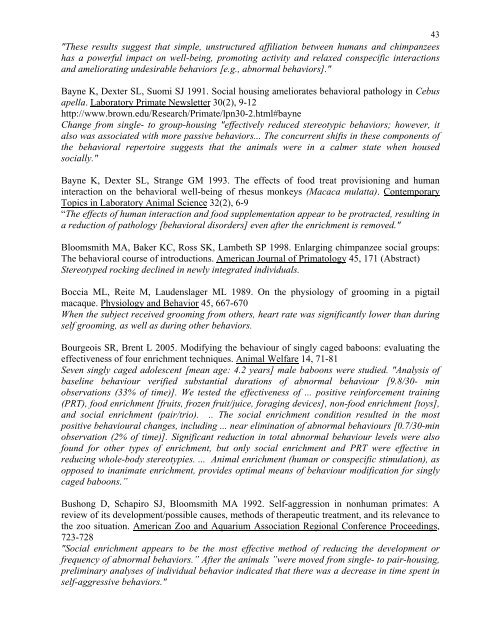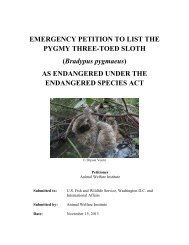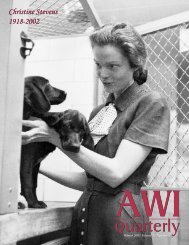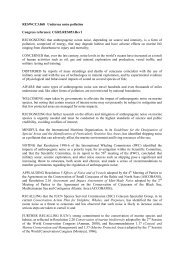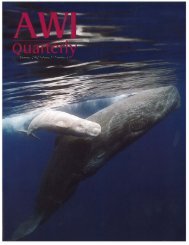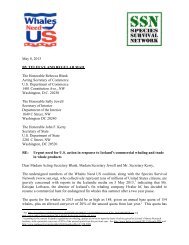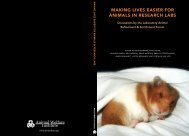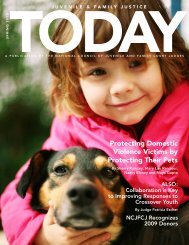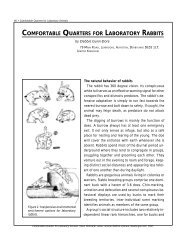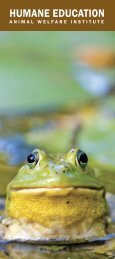43"These results suggest that simple, unstructured affiliation between humans a<strong>nd</strong> chimpanzeeshas a powerful impact on well-being, promoting activity a<strong>nd</strong> relaxed conspecific interactionsa<strong>nd</strong> ameliorating u<strong>nd</strong>esirable behaviors [e.g., abnormal behaviors]."Bayne K, Dexter SL, Suomi SJ 1991. Social housing amelior<strong>ates</strong> behavioral pathology in Cebusapella. Laboratory <strong>Prima</strong>te Newsletter 30(2), 9-12http://www.brown.edu/<strong>Re</strong>search/<strong>Prima</strong>te/lpn30-2.html#bayneChange from single- to group-housing "effectively reduced stereotypic behaviors; however, italso was associated with more passive behaviors... The concurrent shifts in these components ofthe behavioral repertoire suggests that the animals were in a calmer state when housedsocially."Bayne K, Dexter SL, Strange GM 1993. The effects of food treat provisioning a<strong>nd</strong> humaninteraction on the behavioral well-being of rhesus monkeys (Macaca mulatta). ContemporaryTopics in Laboratory Animal Science 32(2), 6-9“The effects of human interaction a<strong>nd</strong> food supple<strong>ment</strong>ation appear to be protracted, resulting ina reduction of pathology [behavioral disorders] even after the enrich<strong>ment</strong> is removed."Bloomsmith MA, Baker KC, Ross SK, Lambeth SP 1998. <strong>En</strong>larging chimpanzee social groups:The behavioral course of introductions. American Journal of <strong>Prima</strong>tology 45, 171 (Abstract)Stereotyped rocking declined in newly integrated i<strong>nd</strong>ividuals.Boccia ML, <strong>Re</strong>ite M, Laudenslager ML 1989. On the physiology of grooming in a pigtailmacaque. Physiology a<strong>nd</strong> Behavior 45, 667-670When the subject received grooming from others, heart rate was significantly lower than duringself grooming, as well as during other behaviors.Bourgeois SR, Brent L 2005. Modifying the behaviour of singly caged baboons: evaluating theeffectiveness of four enrich<strong>ment</strong> techniques. Animal Welfare 14, 71-81Seven singly caged adolescent [mean age: 4.2 years] male baboons were studied. "Analysis ofbaseline behaviour verified substantial durations of abnormal behaviour [9.8/30- minobservations (33% of time)]. We tested the effectiveness of ... positive rein<strong>for</strong>ce<strong>ment</strong> training(PRT), food enrich<strong>ment</strong> [fruits, frozen fruit/juice, <strong>for</strong>aging devices], non-food enrich<strong>ment</strong> [toys],a<strong>nd</strong> social enrich<strong>ment</strong> (pair/trio). .. The social enrich<strong>ment</strong> co<strong>nd</strong>ition resulted in the mostpositive behavioural changes, including ... near elimination of abnormal behaviours [0.7/30-minobservation (2% of time)]. Significant reduction in total abnormal behaviour levels were alsofou<strong>nd</strong> <strong>for</strong> other types of enrich<strong>ment</strong>, but only social enrich<strong>ment</strong> a<strong>nd</strong> PRT were effective inreducing whole-body stereotypies. ... Animal enrich<strong>ment</strong> (human or conspecific stimulation), asopposed to inanimate enrich<strong>ment</strong>, provides optimal means of behaviour modification <strong>for</strong> singlycaged baboons.”Bushong D, Schapiro SJ, Bloomsmith MA 1992. Self-aggression in nonhuman prim<strong>ates</strong>: Areview of its develop<strong>ment</strong>/possible causes, methods of therapeutic treat<strong>ment</strong>, a<strong>nd</strong> its relevance tothe zoo situation. American Zoo a<strong>nd</strong> Aquarium Association <strong>Re</strong>gional Conference Proceedings,723-728"Social enrich<strong>ment</strong> appears to be the most effective method of reducing the develop<strong>ment</strong> orfrequency of abnormal behaviors.” After the animals ”were moved from single- to pair-housing,preliminary analyses of i<strong>nd</strong>ividual behavior i<strong>nd</strong>icated that there was a decrease in time spent inself-aggressive behaviors."
44Choi GC 1993. Humans enrich the lives of lab baboons. WARDS Newsletter 4, 3-7 & 13"The reduction in cage painting a<strong>nd</strong> banging was dramatic a<strong>nd</strong> remarkable" after the singlehousedanimals received more attention from the atte<strong>nd</strong>ing personnel.Coe CL, Franklin D, Smith ER, Levine S 1982. Hormonal responses accompanying fear a<strong>nd</strong>agitation in the squirrel monkey. Physiology a<strong>nd</strong> Behavior 29, 1051-1057"The presence of a social partner reduced signs of behavioral disturbance."Coelho AM, Carey KD, Shade RE 1991. Assessing the effects of social environ<strong>ment</strong> on bloodpressure a<strong>nd</strong> heart r<strong>ates</strong> of baboon. American Journal of <strong>Prima</strong>tology 23, 257-267In the social companion co<strong>nd</strong>ition, a subject was able to have visual, tactile, a<strong>nd</strong> auditoryinteractions with his companion through the wire mesh walls of the specially designed cages."When animals were housed with social companions their blood pressures were consistentlylower than when they were either housed i<strong>nd</strong>ividually or with social strangers. ... Measure<strong>ment</strong>sof cardiovascular physiology obtained u<strong>nd</strong>er social housing may more closely model normalphysiology than ... i<strong>nd</strong>ividual housing."Eaton GG, Kelley ST, Axthelm MK, Iliff-Sizemore SA, Shiigi SM 1994. Psychological wellbeingin paired adult female rhesus (Macaca mulatta). American Journal of <strong>Prima</strong>tology 33, 89-99Paired females show strong preference to spe<strong>nd</strong> time in close proximity; agonistic behaviors arevery infrequent. Health measures, body weight gains, reproduction a<strong>nd</strong> immune responses do notdiffer between dominant, subordinate, a<strong>nd</strong> single-housed females. Paired females spe<strong>nd</strong> less timeengaged in abnormal behavior than single-housed females."Fritz P, Fritz J 1979. <strong>Re</strong>socialization of chimpanzees. Journal of Medical <strong>Prima</strong>tology 8, 202-221"With the exception of Tim, stereotyped behaviors in other i<strong>nd</strong>ividuals decreased almostimmediately upon introduction of a compatible cage mate a<strong>nd</strong> continued to decrease associalization proceeded."Gonzalez CA, Coe CL, Levine S 1982. Cortisol responses u<strong>nd</strong>er different housing co<strong>nd</strong>itions infemale squirrel monkeys. Psychoneuroe<strong>nd</strong>ocrinology 7, 209-216Plasma levels of cortisol "were significantly lower in pair-housed females than in those living ina social group or i<strong>nd</strong>ividually. The incre<strong>ment</strong> in cortisol levels after stress (ha<strong>nd</strong>ling a<strong>nd</strong> etheranesthesia) also was smaller in females housed in pairs." Dominant a<strong>nd</strong> subordinate partners offemale pairs did not differ in their plasma cortisol levels.Goodwin J 1997. The application, use, a<strong>nd</strong> effects of training a<strong>nd</strong> enrich<strong>ment</strong> variables withJapanese snow macaques (Macaca fuscata) at the Central Park Wildlife Center. American Zooa<strong>nd</strong> Aquarium Association <strong>Re</strong>gional Conference Proceedings, 510-515A training protocol is briefly described which allows the keepers through vocal a<strong>nd</strong> visual cuesto herd the animals to a holding area. Training sessions were "deterring stereotypic a<strong>nd</strong>abnormal behaviour - such as excessive grooming a<strong>nd</strong> fur-pulling."Goosen C 1988. Studies of disturbed behaviour in macaques. In Biomedical <strong>Re</strong>search in<strong>Prima</strong>tes. Proceedings of the TNO Symposium Jonker M (ed), 67-74Stereotyped locomotion amounted to about 20% of the time when subjects were housed solitary.The amount of time was reduced to about 4% when the subjects had one or more social partners.
- Page 3: Table of ContentsSpecies-typical Be
- Page 7 and 8: 2Behavioral Pathologies (Abnormal B
- Page 9 and 10: Meyerson BJ 1986. Ethology in anima
- Page 11 and 12: 6"An animal treated unsympathetical
- Page 13 and 14: 8"If sufficient room is not provide
- Page 15 and 16: Canadian Council on Animal Care 198
- Page 17 and 18: 12Platt DM, Kinsey JH, Jorgenson MJ
- Page 19 and 20: 14(7) Enforced RestraintAdams MR, K
- Page 21 and 22: 16Goosen DJ, Davies JH, Maree M, Do
- Page 23 and 24: Norman RL, McGlone J, Smith CJ 1994
- Page 25 and 26: 20Crockett CM, Bowers CL, Shimoji M
- Page 27 and 28: 22(10) Double-tier Cage Arrangement
- Page 29 and 30: National Research Council 1998. The
- Page 31 and 32: 26Coe CL 1991. Is social housing of
- Page 33 and 34: 28Tatoyan SK, Cherkovich GM 1972. T
- Page 35 and 36: 30Line SW, Morgan KN, Markowitz H,
- Page 37 and 38: 32Reinhardt V 1989. Evaluation of t
- Page 39 and 40: 34Clarke AS, Juno CJ, Maple TL 1982
- Page 41 and 42: 36The animals “spent most time in
- Page 43 and 44: 38Brent L, Belik M 1997. The respon
- Page 45 and 46: 40"Access to the puzzles was accomp
- Page 47: 42"The purpose of this study was to
- Page 51 and 52: 46“Eleven baboons who had been si
- Page 53 and 54: 48Reinhardt V, Houser WD, Eisele S,
- Page 55 and 56: 50Thompson MA, Bloomsmith MA, Taylo
- Page 57 and 58: (7) Working with Cooperative Animal
- Page 59 and 60: 54Lambeth SP, Hau J, Perlman JE, Ma
- Page 61 and 62: 56Smith M, Barley J, Down N, Franci
- Page 63 and 64: Environmental Enrichment58(1) Defin
- Page 65 and 66: 60Baker KC, Seres M, Aureli F, de W
- Page 67 and 68: 62Judge PG, de Waal BM, Paul KS, Go
- Page 69 and 70: (2,1,b) Group-housing: Group Format
- Page 71 and 72: 66McNary JK 1992. Integration of ch
- Page 73 and 74: 68Clarke MR, Blanchard JL 1994. All
- Page 75 and 76: Watts E 1997. Introductions. In Ora
- Page 77 and 78: 72Baumans V, Coke C, Green J, Morea
- Page 79 and 80: 74Hotchkiss CE, Paule MG 2003. Effe
- Page 81 and 82: 76Reinhardt V, Hurwitz S 1993. Eval
- Page 83 and 84: 78Shively CA 2001. Psychological we
- Page 85 and 86: 80“The establishment of dominance
- Page 87 and 88: 82Reinhardt V 1991. Agonistic behav
- Page 89 and 90: Abney D, Conlee K, Cunneen M, Down
- Page 91 and 92: 86Boccia ML, Broussard C, Scanlan J
- Page 93 and 94: Southey ER, Baldwin CM 2006. Social
- Page 95 and 96: T-W-Fiennes RN 1972. Primates - Gen
- Page 97 and 98: 927 to 44 training sessions. .. The
- Page 99 and 100:
94Baumans V, Coke C, Green J, Morea
- Page 101 and 102:
96Skoumbourdis EK 2008. Pole-and-co
- Page 103 and 104:
98Tamarins (Saguinus spp.)Smith TE,
- Page 105 and 106:
100Bertrand F, Seguin Y, Chauvier F
- Page 107 and 108:
102Gilloux I, Gurnell J, Shepherdso
- Page 109 and 110:
104Molzen EM, French JA 1989. The p
- Page 111 and 112:
106Reinhardt V 1992. Foraging for c
- Page 113 and 114:
108Boccia ML 1989. Long-term effect
- Page 115 and 116:
110Baumans V, Coke C, Green J, More
- Page 117 and 118:
112”We give our pair-housed cynos
- Page 119 and 120:
114use their hands to obtain and pr
- Page 121 and 122:
116MacLean E, Roberts Prior S 2006.
- Page 123 and 124:
Bayne K, Hurst JK, Dexter SL 1992.
- Page 125 and 126:
120Phillippi-Falkenstein K 1998. Us
- Page 127 and 128:
122Shimoji M, Bowers CL, Crockett C
- Page 129 and 130:
Anonymous 1991. The psychological w
- Page 131 and 132:
126Pruetz JD, Bloomsmith MA 1992. C
- Page 133 and 134:
128Reinhardt V 1990. Time budget of
- Page 135 and 136:
130O'Neill PL, Wright AC, Weed JL 1
- Page 137 and 138:
132above ground level. I very often
- Page 139 and 140:
134Canadian Council on Animal Care
- Page 141 and 142:
136International Primatological Soc
- Page 143 and 144:
138forage daily, by scattering food
- Page 145 and 146:
140sensory and emotional experience
- Page 147 and 148:
142Bayne K 1989 Resolving issues of
- Page 149 and 150:
144creation? Very unlikely!I think
- Page 151:
146Spaeth GL 1994. Editorial: Carin


